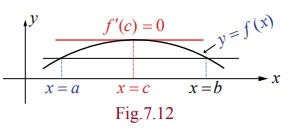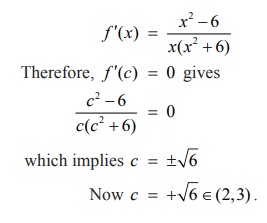Mean Value Theorem | Mathematics - RolleŌĆÖs Theorem | 12th Maths : UNIT 7 : Applications of Differential Calculus
Chapter: 12th Maths : UNIT 7 : Applications of Differential Calculus
RolleŌĆÖs Theorem
RolleŌĆÖs Theorem
Theorem 7.2 (RolleŌĆÖs Theorem)
Let f ( x) be continuous on a closed interval [a , b]
and differentiable on the open interval (a
, b)
If f (a) = f (b) , then there is at least one point c Ōłł (a, b) where fŌĆÖ(c)
=0.

Geometrically
this means that if the tangent is moving along the curve starting at x = a towards as in FigŌĆē7.2 x =
b then there exists a c Ōłł (
a, b) at which the tangent is parallel
to the x -axis.
Example 7.19
Compute
the value of 'c ' satisfied by the
RolleŌĆÖs theorem for the function
f(x) =
x 2 (1 ŌłÆ
x)2 , x Ōłł[0,1] .
Solution
Observe
that, f(0) =
0 =
f (1), f (x) is continuous in
the interval [0,1] and is differentiable in (0,1) . Now,
f ŌĆ▓(
x) = 2x (1ŌłÆ x)(1ŌłÆ 2x)
.
Therefore, f ŌĆ▓(c) = 0 gives c = 0,1 , and 1/2
which ŌćÆ c = 1/2 Ōłł(0,1) .
Example 7.20
Find the
value in the interval (1/2, 2) satisfied by the Rolle's theorem for the
function f(x) = x + 1/x , x Ōłł [1/2 , 2] .
Solution
We have,
f (x) is continuous in [1/2 , 2] and
differentiable in (1/2 , 2) with f(1/2) = 5/2 = f (2) . By the RolleŌĆÖs theorem there must exist a value c Ōłł (1/2 , 2) such that,
f
(c) = 1 ŌĆō 1/c2 = 0 ŌćÆ
c2 = 1 gives c = ┬▒1. As 1Ōłł (1/2 , 2) , we choose c = 1.
Example 7.21
Compute
the value of 'c ' satisfied by
RolleŌĆÖs theorem for the function  in the interval
[2, 3].
in the interval
[2, 3].
Solution
Observe
that, f(2) =
0 =
f (3) and f ( x) is continuous in
the interval [2, 3] and differentiable in (2, 3) . Now,

Observe
that ŌłÆ
ŌłÜ6 Ōłē(2, 3) and hence c = +
ŌłÜ6 satisfies the RolleŌĆÖs theorem.
RolleŌĆÖs
theorem can also be used to compute the number of roots of an algebraic
equation in an interval without actually solving the equation.
Example 7.22
Without
actually solving show that the equation x4
+
2x3 ŌłÆ
2 =
0 has only one real root in the interval (0,1) .
Solution
Let f(x)= x4 + 2x3 ŌłÆ 2. Then f (x) is continuous in [0,1] and differentiable
in (0,1) . Now,
f ŌĆ▓(
x) = 4x3 +
6x2 . If f ŌĆ▓(x)
=
0 then,
2x2 (2x + 3) = 0 .
Therefore, x = 0,ŌłÆ 3/2 but 0, ŌłÆ 3/2 Ōłē(0,1) .
Thus, fŌĆÖ(x) > 0, ŌłĆx Ōłł(0,1) .
Hence by
the RolleŌĆÖs theorem there do not exist a
, b Ōłł(0,1) such that, f (a)
=
0 =
f (b) . Therefore the equation f
(x) = 0 cannot have two roots in the
interval (0,1) . But, f (0) = ŌłÆ2
<
0 and f (1) =
1 >
0 tells us the curve y =
f ( x) crosses the x -axis
between 0 and 1 only once by the Intermediate value theorem. Therefore the
equation x4 +
2x3 ŌłÆ
2 =
0 has only one real root in the interval (0,1) .
As an
application of the RolleŌĆÖs theorem we have the following,
Example 7.23
Prove
using the RolleŌĆÖs theorem that between any two distinct real zeros of the
polynomial
a0xn
+ an-1xnŌłÆ1 + ŌĆ”.. + a1x + a0
there is
a zero of the polynomial
nanxn ŌłÆ1 + ( n ŌłÆ1)anŌłÆ1xnŌłÆ2
+ ŌĆ” + a1.
Solution
Let P (
x) = a0xn + an-1xnŌłÆ1 + ŌĆ”.. + a1x + a0. Let ╬▒ < ╬▓ be two
real zeros of P ( x) . Therefore, P (╬▒ ) = P(╬▓ ) = 0 . Since P ( x) is
continuous in [╬▒ , ╬▓ ] and differentiable in (╬▒ , ╬▓ ) by an application of
RolleŌĆÖs theorem there exists ╬│ Ōłł (╬▒,
╬▓ ) such that P (╬│ ) = 0. Since,
PŌĆ▓(x) = nanxn ŌłÆ1 + ( n ŌłÆ1)anŌłÆ1xnŌłÆ2
+ ŌĆ” + a1.
which
completes the proof.
Example 7.24
Prove
that there is a zero of the polynomial, 2x3
ŌłÆ
9x2 ŌłÆ11x +12 in the interval (2, 7) given that
and 7 are the zeros of the polynomial x4
ŌłÆ
6x3 ŌłÆ11x2 +
24x + 28 .
Solution
Applying
the above example 7.23 with
P(x) = x 4 ŌłÆ 6x3 ŌłÆ 11x2 + 24x + 28, ╬▒ = 2, ╬▓ = 7
and
observing
PŌĆÖ( x) / 2 = 2x3 ŌłÆ 9x2 ŌłÆ 11x +12 = Q(x)
, (say).
This
implies that there is a zero of the polynomial Q ( x) in the interval
(2, 7) .
For
verification,
Q(2) = 16ŌłÆ36ŌłÆ22+12 = 28ŌłÆ58
=ŌłÆ30<0
Q(7) = 686 ŌłÆ 441ŌłÆ 77 +12 = 698 ŌłÆ 518 =180 > 0
From
this we may see that there is a zero of the polynomial Q ( x) in the interval
(2, 7) .
Remark
There
are functions for which RolleŌĆÖs theorem may not be applicable.
(1) For
the function f ( x) = | x |, x Ōłł[ŌłÆ1,1] RolleŌĆÖs theorem is not
applicable, even though f (ŌłÆ1) = 1
= f (1) because f ( x)
is not differentiable at x = 0 .
(2) For
the function,

even
though f (0) =
f (1) = 1 , Rolle's theorem is not
applicable because the function f ( x) is not continuous at x = 0 .
(3) For
the function f (x) = sin x ,
x Ōłł [0, ŽĆ/2] RolleŌĆÖs theorem is not
applicable, even though f (x) is
continuous in the closed interval [0, ŽĆ/2] and differentiable in the open interval
(0, ŽĆ/2) because, 0 = f (0) ŌēĀ f(ŽĆ/2) = 1.
If f ( x)
is continuous in the closed interval [a
, b] and differentiable in the open
interval (a , b) and even if f ( a) ŌēĀ f
(b) then the RolleŌĆÖs theorem can be
generalised as follows.
Theorem 7.1 (Intermediate value theorem)
If f is continuous on a closed interval [a , b] , and c is any number between f (a) and f (b) inclusive, then there is at least one number x in the closed interval [a , b] , such that f ( x) = c .
Related Topics